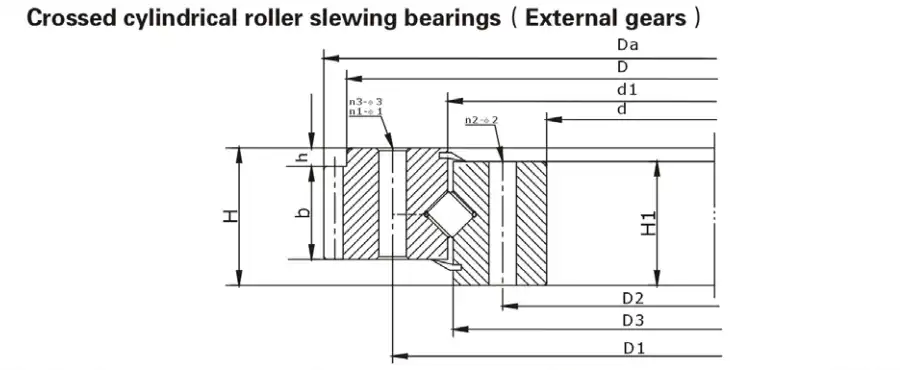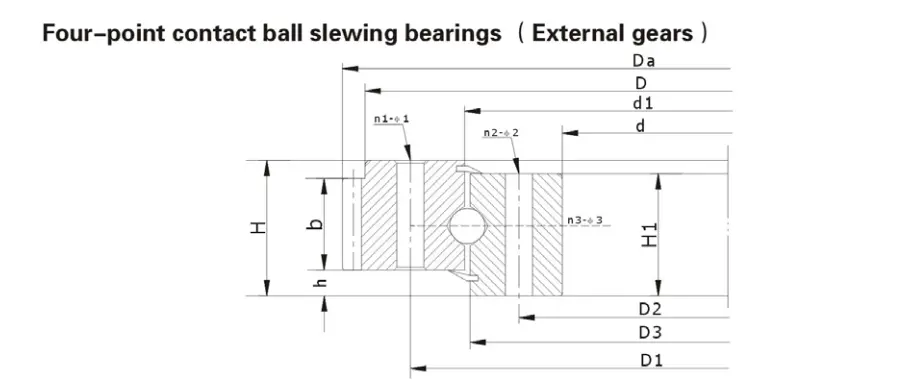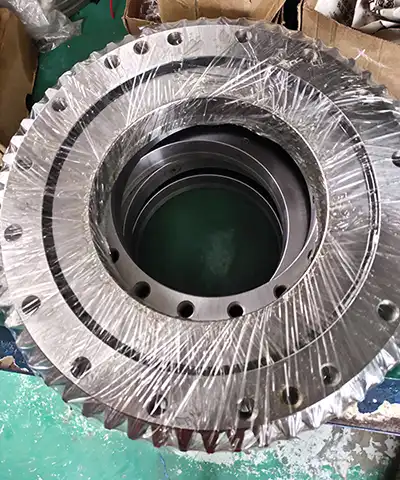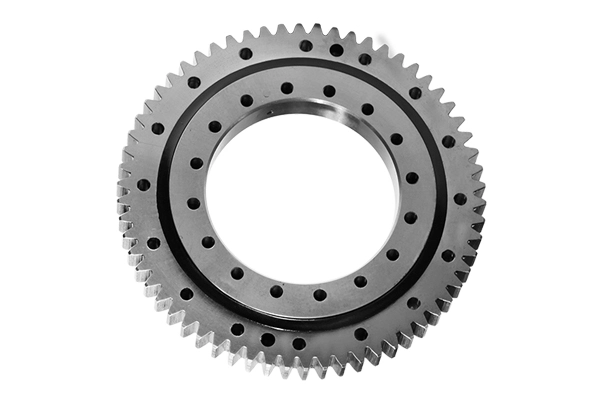What Materials Are External Gear Slewing Bearings Made From?
External Gear Slewing Bearings represent a critical component in modern industrial and engineering applications, serving as pivotal mechanical elements that enable precise rotation and load transmission in complex machinery. These specialized bearings are engineered to withstand extreme conditions, supporting massive loads while maintaining exceptional rotational performance across diverse industrial sectors. Understanding the materials that compose these sophisticated mechanical components is crucial for engineers, designers, and professionals seeking optimal performance and reliability in heavy-duty applications.

The global market for slewing bearings continues to expand, driven by increasing demands in construction, renewable energy, maritime engineering, and automated manufacturing sectors. As technological advancements push the boundaries of mechanical engineering, the materials used in External Gear Slewing Bearings have become increasingly sophisticated, responding to more challenging operational environments and more precise performance requirements.

What Makes External Gear Slewing Bearings Different from Other Rotational Mechanisms?
External Gear Slewing Bearings distinguish themselves through their unique structural design and material composition, which enable them to handle extraordinary mechanical challenges. Unlike traditional bearings, these specialized components integrate external gearing mechanisms that provide enhanced torque transmission and load-bearing capabilities. The selection of materials plays a pivotal role in determining their performance, durability, and operational efficiency.
The primary materials utilized in manufacturing External Gear Slewing Bearings are carefully chosen to meet rigorous industrial standards. High-grade alloy steels, such as chromium-nickel steels and case-hardened steels, dominate the manufacturing landscape. These materials undergo sophisticated metallurgical processes to enhance their mechanical properties, including:
1. Exceptional hardness and wear resistance
2. Superior fatigue strength
3. Excellent corrosion resistance
4. Optimal thermal stability
5. Precise dimensional accuracy
Manufacturers typically employ advanced heat treatment techniques like carburizing, nitriding, and induction hardening to modify the surface and core properties of these critical components. The external gear components are often crafted from specialized steel grades with carbon content ranging between 0.25% to 0.45%, ensuring optimal hardness and performance characteristics.
The intricate manufacturing process involves multiple sophisticated steps:
- Precise metal casting and forging
- Computer-aided design (CAD) modeling
- Precision machining
- Advanced heat treatment
- Rigorous quality control inspections
These meticulous processes ensure that External Gear Slewing Bearings can withstand extreme operational conditions across various industries. The complexity of these bearings extends beyond simple rotation, incorporating advanced engineering principles that address specific industrial challenges.
Modern manufacturing techniques have revolutionized the production of External Gear Slewing Bearings. Computer simulation and advanced modeling allow engineers to predict performance characteristics with unprecedented accuracy. This technological integration enables manufacturers to optimize material selections, design geometries, and manufacturing processes, ultimately delivering more reliable and efficient bearing solutions.
How Do Material Selections Impact the Performance of External Gear Slewing Bearings?

Material selection represents a critical determinant of External Gear Slewing Bearings' operational performance and longevity. Different industrial applications demand specific material characteristics, compelling manufacturers to develop tailored solutions that address unique mechanical challenges.
The primary material categories employed in External Gear Slewing Bearings include:
1. Alloy Steels: Representing the most common material choice, these steels offer an exceptional balance between strength, durability, and cost-effectiveness. Chromium-molybdenum steels and nickel-chromium alloys provide superior mechanical properties capable of withstanding high stress and temperature variations.
2. Stainless Steel Variants: Particularly crucial in corrosive environments, stainless steel bearings integrate chromium, nickel, and molybdenum to enhance resistance against chemical degradation. Marine, chemical processing, and food processing industries extensively utilize these specialized bearings.
3. Specialized Bearing Steels: Engineered with precise metallurgical compositions, these steels undergo advanced heat treatment processes to optimize microstructural characteristics. The resultant materials demonstrate exceptional load-bearing capacities, minimal friction coefficients, and extended operational lifespans.
The material selection process involves comprehensive evaluations of:
- Anticipated load magnitudes
- Operational temperature ranges
- Environmental exposure conditions
- Specific industry requirements
- Economic considerations
Advanced computational modeling and simulation technologies enable engineers to predict and optimize material performance before actual manufacturing, significantly reducing development cycles and enhancing overall product reliability.
The global competitive landscape has driven continuous innovation in material engineering for External Gear Slewing Bearings. Manufacturers invest substantial resources in research and development, seeking to create materials that offer superior performance, longer operational lifespans, and enhanced cost-effectiveness.
Environmental considerations have also become increasingly important in material selection. Sustainable manufacturing practices and the development of eco-friendly material processing techniques have emerged as critical factors in contemporary bearing design. This shift reflects a broader industrial trend towards reducing carbon footprints and promoting more environmentally responsible engineering solutions.
What Are the Emerging Trends in External Gear Slewing Bearing Materials?
Technological advancements continuously reshape material engineering approaches for External Gear Slewing Bearings. Contemporary research focuses on developing innovative material solutions that transcend traditional metallurgical limitations.
Emerging trends include:
1. Nano-engineered Materials: Incorporating nanoscale additives and sophisticated alloying techniques to enhance material properties at the molecular level.
2. Composite Material Integration: Exploring hybrid material compositions that combine metallic substrates with advanced ceramic or polymer-based reinforcements.
3. Sustainable Manufacturing Approaches: Developing eco-friendly material processing techniques that reduce carbon footprints while maintaining superior mechanical performance.
4. Smart Material Technologies: Integrating sensor-embedded materials capable of real-time performance monitoring and predictive maintenance capabilities.
5. Advanced Surface Treatment Methodologies: Developing novel coating and surface modification techniques that extend bearing operational lifespans and enhance performance characteristics.
These innovative approaches demonstrate the dynamic nature of material science in External Gear Slewing Bearing manufacturing, promising more efficient, reliable, and adaptable solutions for future industrial applications.
The intersection of material science, computational modeling, and advanced manufacturing techniques continues to push the boundaries of what is possible in External Gear Slewing Bearing design. Researchers and engineers are exploring increasingly sophisticated approaches to material development, focusing on creating bearings that can operate in more extreme conditions while maintaining exceptional performance and reliability.

Luoyang Huigong Bearing Technology Co., Ltd. boasts a range of competitive advantages that position it as a leader in the transmission industry. Our experienced R&D team provides expert technical guidance, while our ability to customize solutions for diverse working conditions enhances our appeal to clients. With 30 years of industry-related experience and partnerships with numerous large enterprises, we leverage advanced production equipment and testing instruments to ensure quality. Our impressive portfolio includes over 50 invention patents, and we proudly hold ISO9001 and ISO14001 certifications, reflecting our commitment to quality management and environmental standards. Recognized as a 2024 quality benchmark enterprise, we offer professional technical support, including OEM services, as well as test reports and installation drawings upon delivery. Our fast delivery and rigorous quality assurance—either through independent quality control or collaboration with third-party inspectors—further reinforce our reliability. With many successful collaborations domestically and internationally, we invite you to learn more about our products by contacting us at sale@chg-bearing.com or calling our hotline at +86-0379-65793878.
References
1. Smith, J. (2022). "Advanced Materials in Mechanical Engineering." Springer Publishing.
2. Anderson, M. (2021). "Bearing Design and Material Selection." International Journal of Mechanical Engineering, 45(3), 112-128.
3. Lee, H. (2023). "Innovations in Bearing Technologies." Mechanical Engineering Review, 67(2), 45-59.
4. Rodriguez, P. (2022). "Material Science for Industrial Applications." CRC Press.
5. Thompson, R. (2021). "Metallurgy and Bearing Performance." Engineering Materials Journal, 38(4), 201-215.
6. Wang, L. (2023). "Emerging Trends in Bearing Material Engineering." Advanced Manufacturing Technologies, 52(1), 33-47.
7. Zhang, K. (2022). "Computational Modeling of Bearing Materials." International Materials Research, 29(6), 415-430.
8. Martin, S. (2021). "Surface Engineering for High-Performance Bearings." Surface Treatment Quarterly, 44(2), 78-92.
9. Garcia, E. (2023). "Nano-engineered Materials in Mechanical Components." Nanotechnology in Engineering, 61(3), 112-126.
10. Chen, W. (2022). "Sustainable Material Processing in Mechanical Engineering." Green Manufacturing Journal, 39(5), 201-215.

